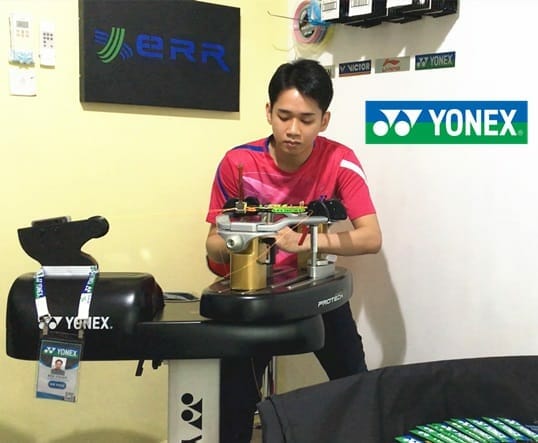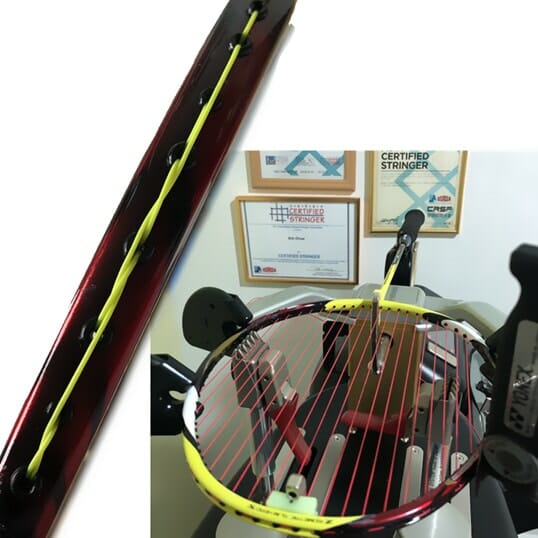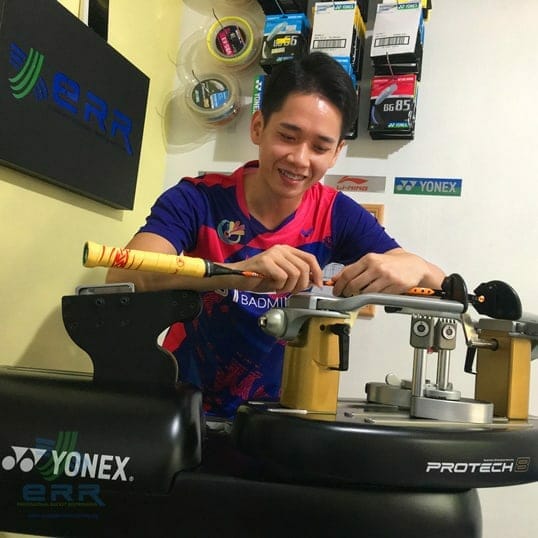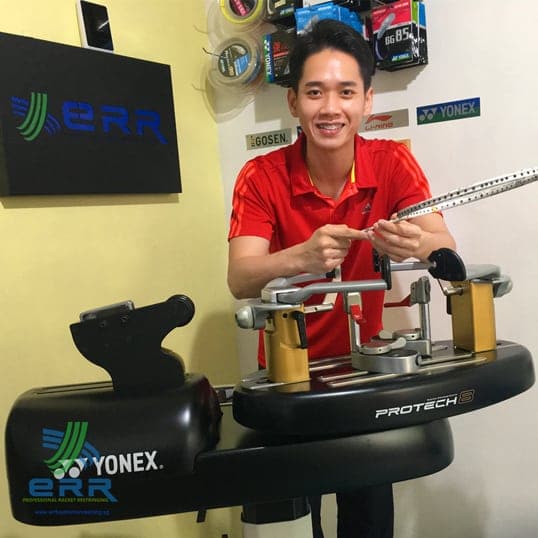Proper Badminton Stringing Shop in Setapak KL
We provide clean, certified badminton stringing for players. Our premium badminton shop in Setapak area mainly focusing on certified badminton restringing services. Our professional stringer is certified with Master Racquet Technician, experienced, and strings rackets according to international tournament stringing standards.

Welcome to the family of
ERR BADMINTON RESTRING KUALA LUMPUR (KL)
ERR Badminton Restring – Proper badminton stringing shop located in Setapak area, Melati Utama, Kuala Lumpur has been providing badminton stringing services to all level players since 2012. Our professional stringer has been serving proper stringing services for many years and is well known in Singapore. He has now decided to relocate to KL with his family. Established with a firm commitment to improving badminton standards in Malaysia, ERR specializes in proper badminton racket stringing and maintenance.
We continually strive to improve our skills and knowledge to stay up to date with the latest stringing technology in the industry. We believe that proper racquet stringing is an important factor for success in the sport in Malaysia.
Our goal is not simply to want to earn money and anyhow string for players; we want to improve every player to have a better understanding in racquet stringing of all ages. We strive to explain our racquet stringing knowledge clearly, using simple language to improve readability and ensure our knowledge is accessible to everyone.
Premium Badminton Stringing

Experienced Stringer
Our Certified Stringer can feel the string and understand what players need. As he is an active badminton player with a deep understanding of the foundation and also an experienced Badminton Coach.

Certified Stringer
Our Stringer is Certified in various certifications including NMC Singapore. Stringing courses include Certified Badminton Stringer, Certified Stringer, Professional Racquet Adviser, Master Racquet Technician, etc.

Calibrated Machine
Our Stringing Machines, Clamp, and stringing tools are all chosen from the most expensive, precise, and highest-class. Our machine tension head are calibrated yearly to make sure at good accuracy.
What is Proper racquet stringing mean?
Have you realized the differences between proper stringing and casual stringing after viewing our badminton stringing video? This is the reason why proper stringing is much more important for every player, regardless of any level.

Focus on Proper Stringing in Setapak KL Malaysia
Since 2007, Mr. Eric Chuar, the founder of ERR Badminton Restring, has been providing badminton stringing services to his Badminton Academy students, fellow enthusiasts, and coach friends. Throughout the last 17 years, he has remained committed to quality and proper stringing, earning trust for his exceptional racket restringing standards.
His extensive experience in the badminton industry has helped him recognize the importance of good quality racquet stringing, which is why he and his team use a Certified Stringing Procedure and sensible stringing patterns for our premium stringing services. Our commitment at ERR Racket Restring is to offer the best badminton restringing services to players of all skill levels, helping them play better and more stably in every skill.

Badminton Restring in Taman Melati / Kuala Lumpur
Understand our professional stringing value
One of the reasons is that the string must be given time to expand equally, ensuring even and consistent tension across the entire racket, which we refer to as ‘Overall Tension.’
This type of stringing process can produce better stringing quality for players, as we have already tried it and found it to be better. Additionally, our stringer is also a certified badminton coach.
Since the overall tension can be distributed evenly, it takes approximately 30 to 45 minutes to string each badminton racket to our accepted standards.
Why does the stringer need to wait for 3 to 4 seconds between each string? Nylon strings require time to stretch and reach a certain length in order to achieve the desired tension.
By giving the strings time to expand, the tension on the racket is distributed evenly and will remain consistent over time. Nylon strings are similar to rubber bands in that consistent stretching can cause them to lose their elasticity and shape.
To achieve maximum repulsion, the thickness of the string is an important factor, as thinner strings tend to lose tension faster than thicker ones. To ensure the best results, our certified badminton stringer devotes more time to the stringing process, particularly when dealing with thin strings and high tension levels.
As a result, we only string according to our capabilities for each day; we will not string when we are tired. This allows us to maintain the highest possible standards of restringing quality for our members. Our commitment is to strictly follow the International Tournament Racquet Restringing Standards.
At ERR Racket Restring, we are committed to raising the standard of badminton stringing in Malaysia, it means we look at good quality stringing is much more important than profits margin. Currently, the local scene focuses more on string type, speed, and low quality fast stringing.
We understand that fast stringing will produce bad results, which don’t have a good hitting sound and feel. To achieve better stringing quality, we will only follow our Certified Stringing Method, which includes waiting 3-4 seconds between each string before proceeding to the next one.
The difference in output quality is much better compared to casual stringing, as shown in the image of an overlapping string, which appears unprofessional and of bad quality. Our founder, Mr. Eric Chuar, aims to offer his students and fellow players the opportunity to experience the benefits of our professional stringing services to ensure they always have a feeling when using the racket strung by us on court.

Empty Frame up to Machine and Strung by Certified Stringer
ERR Badminton Restring will not allow the use of the Pre-String method, as it has been found that pre-weaving the strings can cause critical damage to the strings and reduce their durability. Furthermore, it can lead to inconsistency in overall tension, making it difficult to achieve consistent tension for the racket. The pre-string method can also cause the tension to drop quickly after just a few games.
Even famous badminton players such as Victor Axelsen, Loh Kean Yew, Lee Zii Jia, Jonatan Christie, Kodai Naraoka, and Kento Momota, as well as top women players like Tai Tzu Ying, Akane Yamaguchi, An Se Young, and Chen Yu Fei, regardless of stringing pattern or brand, prefer only the empty frame up to machine stringing method. Strictly No Pre-String method for them. At ERR Racket Restring, we believe in providing the best stringing services using the proper stringing method can help players play and feel better.

Our Promise in Badminton Stringing Services
Following our Certified Stringer’s experience in New Zealand, we strongly believe in the importance of sharing proper stringing knowledge with every badminton player. While we may not provide stringing services throughout the entire Kuala Lumpur region, we are dedicated to focusing on certain areas like Setapak, so that we can share more about stringing knowledge with each of our members.
We specialize in offering badminton stringing service in the Setapak area for higher-level players and badminton lovers who need proper restringing. Our members come from various areas such as Melati Utama, Wangsa Maju, Danau Kota, Seri Setia, Setapak Indah, Gombak, Taman Melawati, Taman Bukit Mas, Damai, Gombak Setia, Kampung Baru, Setia Wangsa, Bukit Jalil, Petaling Jaya, badminton group member from Pro One Badminton Centre, Lavana Sport Centre, Setapak badminton Centre and more.
We wish every one of our members can have good quality stringing services and play better on court. At ERR Racket Restring, we believe that a proper badminton stringing process can help players feel better when using it on court.

Proper Stringing Quality with Proper Knots
At ERR Racket Restring, we understand that no matter how high the quality of the string or how advanced the stringing machine is, proper knotting is still important for achieving excellent stringing results. That’s why we use only professional knots in our stringing process, and we make a commitment to maintaining this standard for as long as we offer our services.
We stand behind this promise by offering a full refund on the spot if any stack string or improper knots are found in our restringing services in Setapak. To ensure the highest level of stringing quality, we also recommend that our members or players check their rackets before leaving our premises. With more than 5000 rackets strung to date, we’re proud to say that no rackets have been found with improper knots or quality.

No Stack, Stick, or Overlapping of String
At ERR Badminton Restring, we understand that not everyone is familiar with industry terms such as “overlapping string” in badminton restringing services. That’s why we take the time to educate our members and share our knowledge with them. Our top-quality stringing process ensures that no cross or overlapping strings are found, as evidenced by the attached photo. We treat every strand of badminton string as a priceless asset for our members, acutely aware that even a minor mistake can compromise the quality of stringing. We are deeply committed to ensuring no mistakes during the stringing process.
We also provide personalized advice to help members choose the most suitable string, tension, brand, model, and thickness for their specific needs as badminton players. Sharing useful tips and information is important to us, as we strive to provide the highest-quality stringing services and ensure that all our members can benefit from our expertise. “Always searching for ‘badminton stringing near me‘? Don’t forget, must look for a proper stringer instead of convenient stringing, which could end up with bad quality and lead to poor play on the court.

Our Good Practices in Racket Stringing Services
1. This approach helps to extend the racket’s durability, as it eliminates the risk of damaging the frame during the stringing process.
2. Stringing an empty frame also ensures firmer string tension with consistent results, making it easier for the owner to locate the sweet spot and hit the shuttlecock accurately.
3. By avoiding overlapping strings during the stringing process, the inner nylon string is protected, which improves the overall durability and consistency of the tension.
1. Ensuring that the racket frame remains relatively unchanged before and after restringing.
2. Preserving the paintwork on the racket and avoiding scratches or other damage.
3. Taking great care to protect the string during the restringing process, as nylon string contains many fine strand like threads that can be easily twisted or damaged if not handled properly. This ensures that the tension remains consistent and comfortable for the player.
4. Ensuring that the tension is equally distributed throughout the entire racket frame to provide the best hitting sound and feel.
We follow the Professional International Stringing Standard and use the world-class YONEX PROTECH series stringing machine.
Our commitment to this certified stringing method has been in place since 2012 and is consistently enjoyed by all ERR members.
At ERR, we want our members to play better, not just because of earning money from such stringing business; we set up stringing services because our founder loves badminton so much.
We are committed to ensuring that our members can have good stringing services, which is why we always advise the right string tension based on each member’s individual game skills and playing style.
We use only the highest quality materials for our badminton string sets, all of which are tested by our stringer and badminton coach. Our string selection does not include strings that only have a high profit margin but are not good to play with.
All our members’ rackets are strung by our Certified Stringer and Master Racquet Technician, while our stringing machine and tools are Yonex’s high-accuracy stringing tool sets sourced from Japan.
By upholding these standards, we guarantee our members will receive the best stringing services in Setapak.
Over the past 17 years, our badminton stringer has continuously tried new stringing methods and technologies, continually improving his skills and knowledge in badminton, as this benefits our members. Mr. Eric Chuar, our professional stringer, always keeps his commitment to following proper procedures and techniques when restringing rackets. He firmly believes that taking shortcuts in stringing just to save a few minutes of time will not benefit members, as the reason is simply to earn a few extra dollars in stringing price.
This is why you can see that we normally reject all walk-in customers, making sure they all book online and send their rackets over because our stringer only wants to produce good quality stringing. This can benefit both parties, as members can receive 100% perfect stringing services, and our stringer can feel good because the money he earns is from his true professional efforts.
Since 2012, ERR has consistently fulfilled all of the commitments made to its members, until now 2024.

Combination of Stringing Methods that Meet the Highest Standards of Quality and Precision
The stringing method used can impact the final result, which is why our ERR Certified Stringer bases their knowledge of badminton restringing to determine which stringing pattern is good for each individual player. In addition, the stringing foundation is important, as if the stringer has no proper foundation in stringing, they will not be able to produce good quality stringing for sure. Actually, it’s the same as badminton foundation; a person who plays badminton but has not learned any proper foundation will not be able to play better compared to a player who has learned proper foundation.
To ensure that our members receive the best stringing service, we gather feedback on every new string from our 2000 member base. Our commitment to quality means that we do not accept any low-quality strings or stringing methods, even if they offer higher profit margins. Also, with our good knowledge of Certified Stringer and the precision of our Yonex Protech Stringing Machine, we can deliver the best stringing services for members. In Malaysia KL Setapak, we are steadily spreading our professional badminton stringing service to players who truly love badminton, so that slowly in the future we can establish a proper stringing foundation throughout Malaysia, indirectly helping to raise the badminton standard in Malaysia.

Stringing Machine Calibrated with ISO/IEC 17025 Standard
We always take care of our Yonex Protech Series stringing machine. Every year and half yearly, our tension head and clamp are performed onsite calibration and calibrated by the SAC SINGLAS Laboratory, accredited to the ISO/IEC 17025 or NIST Standard. This certification is traceable to National or International Standards, ensuring our machines are within accuracy and acceptance tolerance. Not every badminton stringing service provider is willing to make this investment, but we deeply believe in its importance to see the data and accuracy.
Our tension head and stringing clamp undergo yearly calibration and must operate within strict tolerances to maintain accuracy. Additionally, our daily routine includes cleaning the clamp and track and conducting a tension test before restringing. Our commitment to accuracy helps us provide quality services to our members, as evidenced by our stringer’s qualifications as a Certified Badminton Stringer and Certified Badminton Coach in Malaysia. The best badminton stringing service isn’t just about renovation or good marketing, expensive prices, or a good stringing machine to attract people to come to you; it’s about how much effort you are willing to spend on each stringing service and how to help players play better on the court.
Book Proper Racquet Stringing Online
For best badminton restringing service quality, membership is required to utilize the “BOOK” button and schedule an appointment for stringing. The booking system is now available to the general public, having previously been exclusive to ERR members, and has been fully developed.
Important Note: We do not accept walk-ins for racquet stringing, as professional badminton stringing requires additional time. Therefore, our stringer has to plan the schedule properly. All members are required to book an appointment online before visiting our facility.
Our Badminton Stringing Address:
G-3 PV6 Platinum Hill Condo, No 3 Jalan Melati 3, Taman Melati Utama 53100 Kuala Lumpur, Malaysia

